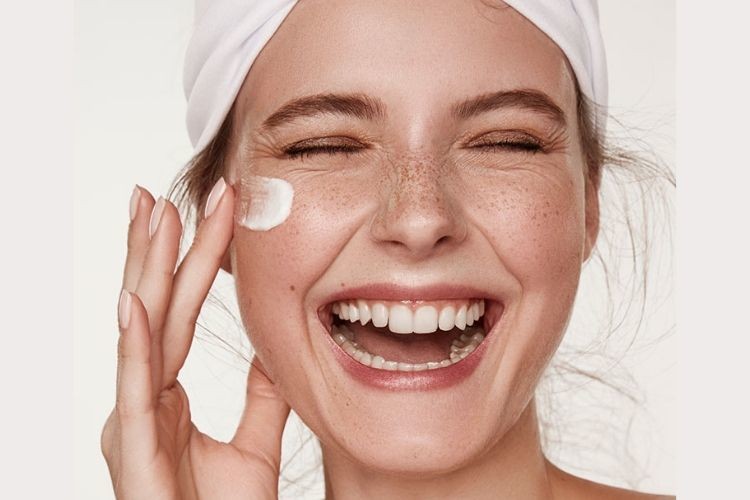Premature skin ageing occurs because the skin, as the outermost organ, is always directly exposed to oxidants in the environment and is frequently a determining factor in social life. In addition, with increasing age, the activity of mitochondria in the body as a producer of energy in regenerating cells and tissues decreases. Both these internal and external factors cause impaired tissue function and structural changes culminating in skin ageing characterized by thinning of the epidermis and skin dermis and, ultimately, resulting in wrinkles, fine facial lines, and loss of elasticity. Skin elasticity is largely dependent upon young collagen fibres and fibroblasts, collagen-producing cells in the dermis layer, whose numbers decrease during the ageing process.
Coenzyme Q10 (CoQ10) is one of the natural compounds often employed as an antioxidant, which plays a key role in stabilizing plasma and other intracellular membranes that protect against membrane phospholipid peroxidation7. During ageing, the levels of CoQ10 in organs, including the skin, also decrease with the result that it is necessary to supply CoQ10 to achieve normal levels of between 0.50 and 1.65 mg/mL within the body. Topical administration of CoQ10 has been shown to be effective in reducing wrinkles in skin that has been exposed to UV rays. CoQ10 acts by maintaining skin quality against free radicals which have been known to activate the mitogen-activated protein kinase (MAPK) pathway that produces matrix metalloproteinases (MMPs) such as collagenase, thus damaging collagen fibres.
CoQ10 demonstrates low solubility in water (0.193 mg/mL) with a large molecular weight of 863.36 g/mol and high lipophilicity with a log P value of 21. This limits its penetration of the skin and explains it tends to be deposited in the stratum corneum. The strategy to reduce such limitations is to trap the active ingredients in the Protransfersome system.
Researchers from the Faculty of Pharmacy UNAIR have developed an emulgel-based mask preparation containing Coenzyme Q10 in the form of protransfersomes that have the potential to inhibit premature ageing of the skin. Protransfersome, one of the provesicular nanocarriers that provide superior skin penetration and high stability, is widely used in transdermal delivery. It possesses a fattened liquid crystal structure which is converted into an ultra-flexible vesicle known as transfersome through the absorption of water from the skin during in situ hydration.
After dissolving the CoQ10 in oleic acid and encapsulated it into protransfersomes composed of phospholipids and Tween 80. This preparation has a pH value of 6.4 which enters the skin pH range so that the risk of irritation is small with a fairly high trapping efficiency, which is 45.64 ± 7.52%. When protransfersomes are observed using a light microscope, the lamellar line structure is visible in the form of liquid crystals.
Tests for the particle size of the Protransfersomy CoQ10 system showed results of 201.5 ± 6.1 nm with a polydispersity index value of 0.229 ± 0.047 indicating uniform particle size. While the particle size of three different mask formulas shows the Protransfersom CoQ10 Emulgel has the smallest particle size compared to CoQ10 Ole-emulgel, where CoQ10 is dissolved in Oleic Acid and then dispersed at the base of emulgel, and coQ10 dispersion in emulgel (CoQ10 emulgel) which is 134.3 ± 4.8 nm
In pH stability testing, particle size, and particle size distribution in protransfersome systems and protransfersome masks at different temperatures, pH values, particle size, and stable particle size distributions during 28-day storage.
To evaluate the ability of protransfersomes to topically deliver CoQ10 and produce an effective anti-ageing activity, the Protransf-CoQ10 Emulgel was topically applied for 14 days to the back skin of UV-rays-induced subjects who were subsequently observed for skin histopathology. The control group subjects which received UV rays had the lowest collagen density of 52.30±7.87%, indicating that UV rays damage the collagen in the skin dermis. The administration of both Protransf-CoQ10 Emulgel and CoQ10-Ole Emulgel significantly improved the collagen density of UV ray radiated subjects’ skin as indicated in Fig. 6. However, there was no significant difference between these groups. the use of protransfersomes successfully delivered CoQ10 providing protection against skin damage and repaired that resulting from exposure to UV rays.
The anti-ageing activity test result was further analyzed by observing the number of fibroblast cells capable of producing collagen. Therefore, the higher the number of fibroblasts, the more collagen was formed. In this study, the assessed fibroblasts were young and light purple in appearance. The results showed that the CoQ10 Emulgel had a significantly different number of fibroblasts compared to the control group, with pro-CoQ10 Emulgel producing the highest number of fibroblasts, which was 31.50±9.48 cells per field view. the results indicated that the Protransf-CoQ10 Emulgel produced no signs of irritation in the skin tissues observed, while the CoQ10-Ole Emulgel induced mild skin irritation due to the nature of oleic acid.
From this study, the results obtained that the protransfersome system that has been utilized as a delivery system for coQ10 active ingredients has a good ability of characteristic properties, penetration ability, increased antiaging activity, and has low irritability. Protransfersomes have great potential as a cosmetic active ingredient delivery system.
Author: Apt. Andang Miatmoko, Ph.D.
Reference: Ayunin, Q., Miatmoko, A., Soeratri, W. et al. Improving the anti-ageing activity of coenzyme Q10 through protransfersome-loaded emulgel. Sci Rep 12, 906 (2022). https://doi.org/10.1038/s41598-021-04708-4





